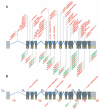A distinct clinical, neuropsychological and radiological phenotype is associated with progranulin gene mutations in a large UK series
- PMID: 18234697
- PMCID: PMC2577762
- DOI: 10.1093/brain/awm320
A distinct clinical, neuropsychological and radiological phenotype is associated with progranulin gene mutations in a large UK series
Abstract
Mutations in the progranulin gene (GRN) are a major cause of frontotemporal lobar degeneration with ubiquitin-positive, tau-negative inclusions (FTLD-U) but the distinguishing clinical and anatomical features of this subgroup remain unclear. In a large UK cohort we found five different frameshift and premature termination mutations likely to be causative of FTLD in 25 affected family members. A previously described 4-bp insertion mutation in GRN exon 2 comprised the majority of cases in our cohort (20/25), with four novel mutations being identified in the other five affected members. Additional novel missense changes were discovered, of uncertain pathogenicity, but deletion of the entire gene was not detected. The patient collection was investigated by a single tertiary referral centre and is enriched for familial early onset FTLD with a high proportion of patients undergoing neuropsychological testing, MRI and eventual neuropathological diagnosis. Age at onset was variable, but four mutation carriers presented in their 40s and when analysed as a group, the mean age at onset of disease in GRN mutation carriers was later than tau gene (MAPT) mutation carriers and duration of disease was shorter when compared with both MAPT and FTLD-U without mutation. The most common clinical presentation seen in GRN mutation carriers was behavioural variant FTLD with apathy as the dominant feature. However, many patients had language output impairment that was either a progressive non-fluent aphasia or decreased speech output consistent with a dynamic aphasia. Neurological and neuropsychological examination also suggests that parietal lobe dysfunction is a characteristic feature of GRN mutation and differentiates this group from other patients with FTLD. MR imaging showed evidence of strikingly asymmetrical atrophy with the frontal, temporal and parietal lobes all affected. Both right- and left-sided predominant atrophy was seen even within the same family. As a group, the GRN carriers showed more asymmetry than in other FTLD groups. All pathologically investigated cases showed extensive type 3 TDP-43-positive pathology, including frequent neuronal cytoplasmic inclusions, dystrophic neurites in both grey and white matter and also neuronal intranuclear inclusions. Finally, we confirmed a modifying effect of APOE-E4 genotype on clinical phenotype with a later onset in the GRN carriers suggesting that this gene has distinct phenotypic effects in different neurodegenerative diseases.
Figures





References
-
- Baker M, Mackenzie IR, Pickering-Brown SM, Gass J, Rademakers R, Lindholm C, et al. Mutations in progranulin cause tau-negative frontotemporal dementia linked to chromosome 17. Nature. 2006;442:916–9. Epub 2006 Jul 16. - PubMed
-
- Baxter DM, Warrington EK. Measuring dysgraphia: a graded-difficulty spelling test. Behav Neurol. 1994;7:107–16. Epub 2006 Jul 16. - PubMed
-
- Behrens MI, Mukherjee O, Tu PH, Liscic RM, Grinberg LT, Carter D, et al. Neuropathologic heterogeneity in HDDD1: a familial frontotemporal lobar degeneration with ubiquitin-positive inclusions and progranulin mutation. Alzheimer Dis Assoc Disord. 2007;21:1–7. - PubMed
-
- Benussi L, Binetti G, Sina E, Gigola L, Bettecken T, Meitinger T, et al. A novel deletion in progranulin gene is associated with FTDP-17 and CBS. Neurobiol Aging. 2006 [Epub ahead of print] - PubMed
-
- Bird T, Knopman D, VanSwieten J, Rosso S, Feldman H, Tanabe H, et al. Epidemiology and genetics of frontotemporal dementia/Pick's disease. Ann Neurol. 2003;54:S29–31. - PubMed
Publication types
MeSH terms
Substances
Grants and funding
LinkOut - more resources
Full Text Sources
Medical
Research Materials
Miscellaneous

